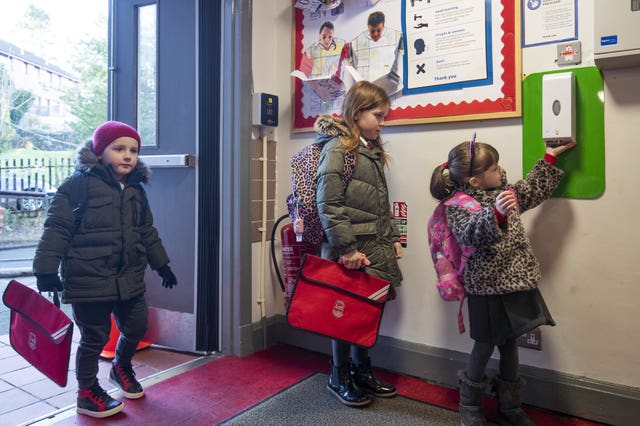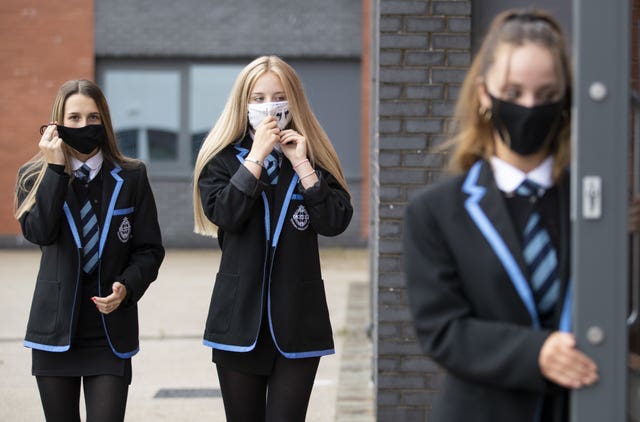
MORE pupils return to classrooms across Scotland today as the latest phase of lockdown easing sets in.
Children in primaries 4-7 are due to join their younger classmates who were the first to go back to school on February 22.
Senior secondary school pupils required to attend for practical work for qualifications were able to return from the same date.
 P1-P3 pupils returned on February 22
P1-P3 pupils returned on February 22
Now, all high school students can head back to the classroom part-time, as part of a blended learning model meaning they will continue to do some learning at home until after the Easter break.
Secondary school pupils are required to observe two-metre social distancing in school and on school transport as well as wearing face coverings.
Nicola Sturgeon confirmed the plans in a speech to MSPs on March 2 and has repeatedly stressed that having pupils return to school is her lockdown easing priority.
READ MORE: Scottish dental schools not accepting new students in 2021
She previously defended the partial return for secondary school pupils, despite being told some youngsters could spend less than two hours a week in the classroom.
The First Minister told MSPs on Wednesday: “We decided to try, even if it was limited, in the period between now and Easter to get young people back into school for some periods and to reacquaint them ahead of the Easter holidays.
“We are trying to get back to the provision of full-time education as quickly as is possible, and to recognise the need to introduce, even if it is partial, and even if it is phased, and even if it is limited, greater degrees of normality for young people from now onwards.”
However, the decision came under fire from a senior teaching union figure on Sunday.
 Pupils need to observe two-metre social distancing in school and wear face coverings
Pupils need to observe two-metre social distancing in school and wear face coverings
Assistant secretary of the EIS teaching union Andrea Bradley claimed the decision was “politically motivated” as the Scottish Government needed a “good news story” amid the Alex Salmond saga.
Education Secretary John Swinney said the Government’s “sole motivation” was ensuring pupils’ wellbeing.
However, Ms Bradley told BBC Scotland’s Sunday Show: “The decision seemed to be a political one rather than one that was based on sound educational principle.
READ MORE: Scottish Government releases latest Covid-19 case numbers
“Certainly it wasn’t one that has taken account of the very real circumstances in which teachers are working – under quite significant stress and pressure over the last six months.”
She said teachers are “really struggling” with the workload.
She added: “We have to have cognisance of the context in which the decision was announced, it took place before the parliamentary evidence-giving session.
“Our sense was the Government were looking for a good news story that week.”
The day after making the announcement, the First Minister gave evidence at the Holyrood committee examining the Scottish Government’s botched handling of sexual harassment claims against her predecessor.

Scottish Conservative education spokesman Jamie Greene said: “It is startling to hear a senior teaching union official effectively accuse Nicola Sturgeon of using Scotland’s school pupils for political distraction.
“The suggestion appears to be that the First Minister announced an earlier return to the classroom not for legitimate reasons but to draw attention away from her evidence to the Salmond inquiry.
“For that to be alleged is extraordinary and speaks to the erosion in trust in this SNP administration.”
Mr Swinney told the same programme: “We were concerned about wellbeing of S1 to S3 pupils, who might feel excluded from the return to school if we didn’t give them some opportunity for face-to-face learning before the Easter holidays.
“That was the one and only motivation that the Government had.”
He added: “I’ve listened to young people directly myself who are concerned about the effects on their own wellbeing of the loss of social interaction with their peers and with their teachers, so that’s why all secondary pupils are returning for some elements of education and face-to-face learning in the forthcoming few weeks.”



Why are you making commenting on The Herald only available to subscribers?
It should have been a safe space for informed debate, somewhere for readers to discuss issues around the biggest stories of the day, but all too often the below the line comments on most websites have become bogged down by off-topic discussions and abuse.
heraldscotland.com is tackling this problem by allowing only subscribers to comment.
We are doing this to improve the experience for our loyal readers and we believe it will reduce the ability of trolls and troublemakers, who occasionally find their way onto our site, to abuse our journalists and readers. We also hope it will help the comments section fulfil its promise as a part of Scotland's conversation with itself.
We are lucky at The Herald. We are read by an informed, educated readership who can add their knowledge and insights to our stories.
That is invaluable.
We are making the subscriber-only change to support our valued readers, who tell us they don't want the site cluttered up with irrelevant comments, untruths and abuse.
In the past, the journalist’s job was to collect and distribute information to the audience. Technology means that readers can shape a discussion. We look forward to hearing from you on heraldscotland.com
Comments & Moderation
Readers’ comments: You are personally liable for the content of any comments you upload to this website, so please act responsibly. We do not pre-moderate or monitor readers’ comments appearing on our websites, but we do post-moderate in response to complaints we receive or otherwise when a potential problem comes to our attention. You can make a complaint by using the ‘report this post’ link . We may then apply our discretion under the user terms to amend or delete comments.
Post moderation is undertaken full-time 9am-6pm on weekdays, and on a part-time basis outwith those hours.
Read the rules hereLast Updated:
Report this comment Cancel